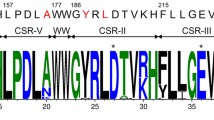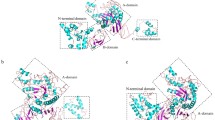Abstract
α-Amylases from Bacillus licheniformis (BLA) and Bacillus amyloliquefaciens (BAA) are both important industrial enzymes with high similarity in structure but significant differences in thermostability. The mechanisms underlying this discrepancy are still poorly understood. Here, we investigated the role of two amino acids’ insertion on the thermostability of these two group amylases. A newly obtained thermophilic amylase AMY121 was found much closer to BLA in both primary structure and enzymological properties. Two amino acids’ insertion widespread among BAA group α-amylases was identified as one of the key factors leading to the thermostability differences, since thermostability of insertion mutants (AMY121-EG and AMY121-AA) from AMY121 significantly decreased, while that of deletion mutant from BAA increased. Moreover, we proposed that conformational disturbance caused by insertion mutation might weaken the calcium-binding affinity and consequently decrease the enzyme thermostability.





Similar content being viewed by others
References
Kloosterman WMJ, Jovanovic D, Brouwer SGM, Loos K (2014) Amylase catalyzed synthesis of glycosyl acrylates and their polymerization. Green Chem 16(1):203–210. doi:10.1039/C3gc41471j
Guzman-Maldonado H, Paredes-Lopez O (1995) Amylolytic enzymes and products derived from starch: a review. Crit Rev Food Sci Nutr 35(5):373–403. doi:10.1080/10408399509527706
Vihinen M, Mantsala P (1989) Microbial amylolytic enzymes. Crit Rev Biochem Mol Biol 24(4):329–418. doi:10.3109/10409238909082556
van der Maarel MJ, van der Veen B, Uitdehaag JC, Leemhuis H, Dijkhuizen L (2002) Properties and applications of starch-converting enzymes of the alpha-amylase family. J Biotechnol 94(2):137–155
Alikhajeh J, Khajeh K, Ranjbar B, Naderi-Manesh H, Lin YH, Liu EH, Guan HH, Hsieh YC, Chuankhayan P, Huang YC, Jeyaraman J, Liu MY, Chen CJ (2010) Structure of Bacillus amyloliquefaciens alpha-amylase at high resolution: implications for thermal stability. Acta Crystallogr F 66:121–129. doi:10.1107/S1744309109051938
Nigam P, Singh D (1995) Enzyme and microbial systems involved in starch processing. Enzyme Microb Tech 17(9):770–778
Khajeh K, Ranjbar B, Naderi-Manesh H, Habibi AE, Nemat-Gorgani M (2001) Chemical modification of bacterial alpha-amylases: changes in tertiary structures and the effect of additional calcium. BBA-Protein Struct M 1548(2):229–237. doi:10.1016/S0167-4838(01)00236-9
Violet M, Meunier JC (1989) Kinetic study of the irreversible thermal denaturation of Bacillus licheniformis alpha-amylase. Biochem J 263(3):665–670
Machius M, Wiegand G, Huber R (1995) Crystal Structure of calcium-depleted Bacillus licheniformis α-amylase at 2.2 Å resolution. J Mol Biol 246(4):545–559
Conrad B, Hoang V, Polley A, Hofemeister J (1995) Hybrid Bacillus amyloliquefaciens × Bacillus licheniformis α-amylases. Eur J Biochem 230(2):481–490
Fitter J (2005) Structural and dynamical features contributing to thermostability in alpha-amylases. Cell Mol Life Sci: CMLS 62(17):1925–1937. doi:10.1007/s00018-005-5079-2
Zonouzi R, Khajeh K, Monajjemi M, Ghaemi N (2013) Role of the salt bridge between Arg176 and Glu126 in the thermal stability of the Bacillus amyloliquefaciens alpha-amylase (BAA). J Microbiol Biotechnol 23(1):7–14. doi:10.4014/jmb.1205.05062
Trincone A (2010) Potential biocatalysts originating from sea environments. J Mol Catal B-Enzym 66(3–4):241–256. doi:10.1016/j.molcatb.2010.06.004
Bernfeld P (1955) Amylases, alpha and beta. Methods Enzymol I:149–158
Bradford MM (1976) A rapid and sensitive method for the quantitation of microgram quantities of protein utilizing the principle of protein-dye binding. Anal Biochem 72(1):248–254
Cardoso J, Emery A (1978) A new model to describe enzyme inactivation. Biotechnol Bioeng 20(9):1471–1477
Zheng L, Baumann U, Reymond JL (2004) An efficient one-step site-directed and site-saturation mutagenesis protocol. Nucleic Acids Res 32(14):e115. doi:10.1093/nar/gnh110
Petersen TN, Brunak S, von Heijne G, Nielsen H (2011) SignalP 4.0: discriminating signal peptides from transmembrane regions. Nat Methods 8(10):785–786. doi:10.1038/nmeth.1701
Sajedi RH, Naderi-Manesh H, Khajeh K, Ahmadvand R, Ranjbar BA, Asoodeh A, Moradian F (2005) A Ca-independent alpha-amylase that is active and stable at low pH from the Bacillus sp KR-8104. Enzyme Microb Technol 36(5–6):666–671. doi:10.1016/j.enzmictec.2004.11.003
Liu XD, Xu Y (2008) A novel raw starch digesting alpha-amylase from a newly isolated Bacillus sp YX-1: purification and characterization. Bioresource Technol 99(10):4315–4320. doi:10.1016/j.biortech.2007.08.040
Hmidet N, Bayoudh A, Berrin JG, Kanoun S, Juge N, Nasri M (2008) Purification and biochemical characterization of a novel alpha-amylase from Bacillus licheniformis NH1—cloning, nucleotide sequence and expression of amyN gene in Escherichia coli. Process Biochem 43(5):499–510. doi:10.1016/j.procbio.2008.01.017
Liu XD, Xu Y (2008) A novel raw starch digesting alpha-amylase from a newly isolated Bacillus sp. YX-1: purification and characterization. Bioresour Technol 99(10):4315–4320. doi:10.1016/j.biortech.2007.08.040
Liu Y, Shen W, Shi GY, Wang ZX (2010) Role of the calcium-binding residues Asp231, Asp233, and Asp438 in alpha-amylase of Bacillus amyloliquefaciens as revealed by mutational analysis. Curr Microbiol 60(3):162–166. doi:10.1007/s00284-009-9517-5
Dong GQ, Vieille C, Savchenko A, Zeikus JG (1997) Cloning, sequencing, and expression of the gene encoding extracellular alpha-amylase from Pyrococcus furiosus and biochemical characterization of the recombinant enzyme. Appl Environ Microb 63(9):3569–3576
Nielsen AD, Pusey ML, Fuglsang CC, Westh P (2003) A proposed mechanism for the thermal denaturation of a recombinant Bacillus halmapalus alpha-amylase—the effect of calcium ions. BBA-Proteins Proteom 1652(1):52–63. doi:10.1016/j.bbapap.2003.08.002
Laderman KA, Davis BR, Krutzsch HC, Lewis MS, Griko YV, Privalov PL, Anfinsen CB (1993) The purification and characterization of an extremely thermostable alpha-amylase from the hyperthermophilic archaebacterium Pyrococcus furiosus. J Biol Chem 268(32):24394–24401
Boren K, Andersson P, Larsson M, Carlsson U (1999) Characterization of a molten globule state of bovine carbonic anhydrase-III: loss of asymmetrical environment of the aromatic residues has a profound effect on both the near- and far-UV CD spectrum. BBA-Protein Struct M 1430(1):111–118. doi:10.1016/S0167-4838(98)00283-0
Kundrat MD, Autschbach J (2006) Time dependent density functional theory modeling of specific rotation and optical rotatory dispersion of the aromatic amino acids in solution. J Phys Chem A 110(47):12908–12917. doi:10.1021/Jp064636
Brown I, Dafforn TR, Fryer PJ, Cox PW (2013) Kinetic study of the thermal denaturation of a hyperthermostable extracellular alpha-amylase from Pyrococcus furiosus. Biochimica et biophysica acta 1834 12:2600–2605. doi:10.1016/j.bbapap.2013.09.008
Yang J, Li J, Mai ZM, Tian XP, Zhang S (2013) Purification, characterization, and gene cloning of a cold-adapted thermolysin-like protease from Halobacillus sp SCSIO 20089. J Biosci Bioeng 115(6):628–632. doi:10.1016/j.jbiosc.2012.12.013
Gohel V, Naseby DC (2007) Thermal stabilization of chitinolytic enzymes of Pantoea dispersa. Biochem Eng J 35(2):150–157. doi:10.1016/j.bej.2007.01.009
Declerck N, Machius M, Wiegand G, Huber R, Gaillardin C (2000) Probing structural determinants specifying high thermostability in Bacillus licheniformis alpha-amylase. J Mol Biol 301(4):1041–1057. doi:10.1006/jmbi.2000.4025
Acknowledgments
This research was supported by Administration of Ocean and Fisheries of Guangdong Province (GD2012-D01-002), National High Technology Research and Development Program of China (863 Program, 2012AA092104), Public Science and Technology Research Funds Projects of Ocean (Grant: 201305018), the National Natural Science Foundation of China (Grant NO. 41406193), “Strategic Priority Research Program” of the Chinese Academy of Sciences, Grant NO. XDA10030400, the Knowledge Innovation Program of the Chinese Academy of Sciences (SQ201301) and the Key Research Program of the Chinese Academy of Sciences, Grant NO.KSCX2-EW-B-13.
Author information
Authors and Affiliations
Corresponding author
Additional information
Lizhen Li and Jian Yang contributed equally to this work.
Rights and permissions
About this article
Cite this article
Li, L., Yang, J., Li, J. et al. Role of two amino acid residues’ insertion on thermal stability of thermophilic α-amylase AMY121 from a deep sea bacterium Bacillus sp. SCSIO 15121. Bioprocess Biosyst Eng 38, 871–879 (2015). https://doi.org/10.1007/s00449-014-1330-2
Received:
Accepted:
Published:
Issue Date:
DOI: https://doi.org/10.1007/s00449-014-1330-2




